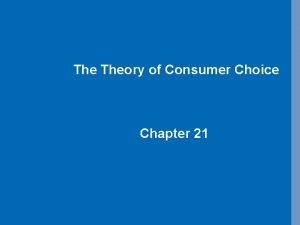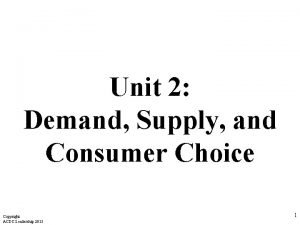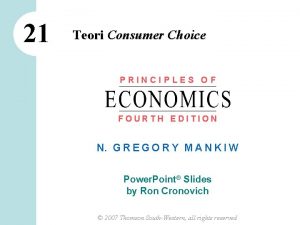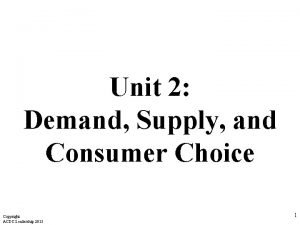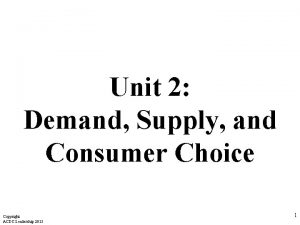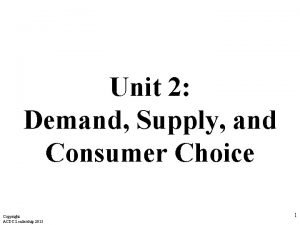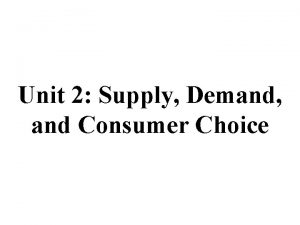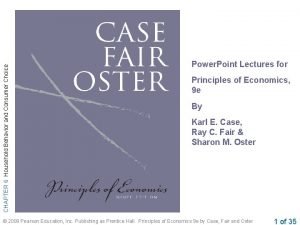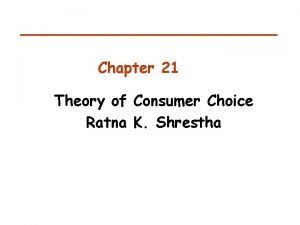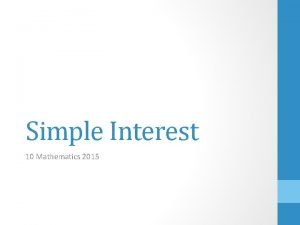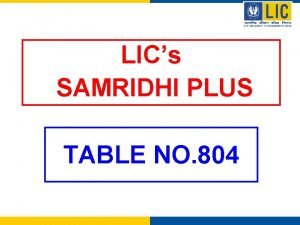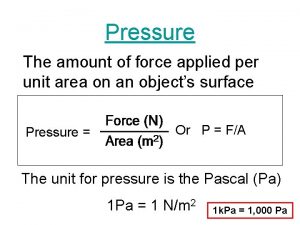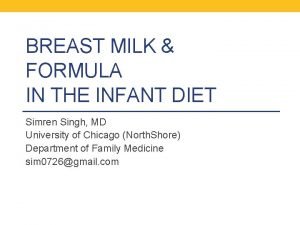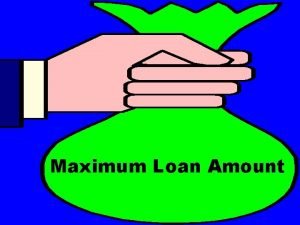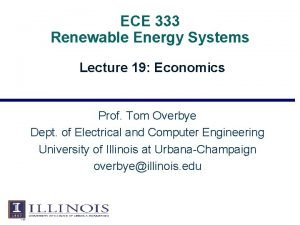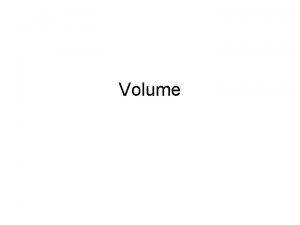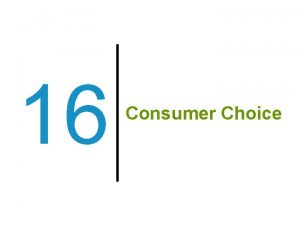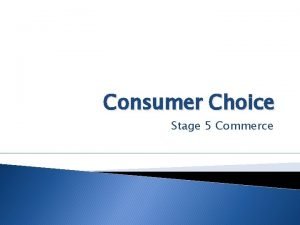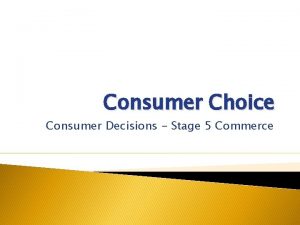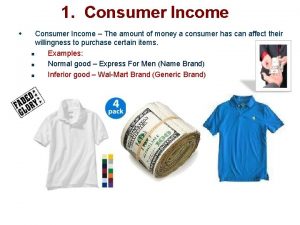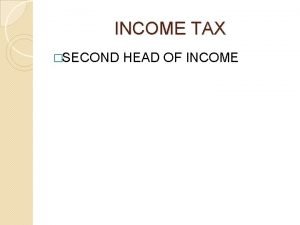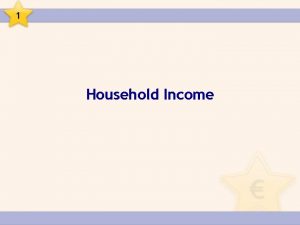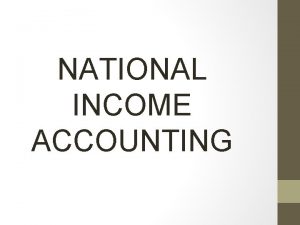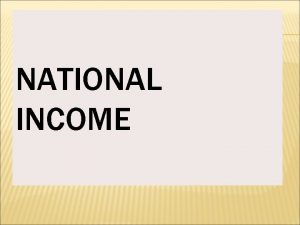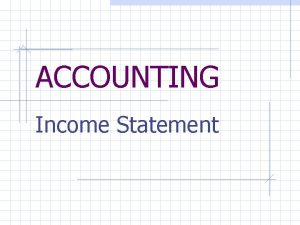16 Consumer Choice Previously Some amount of income












































- Slides: 44

16 Consumer Choice

Previously • Some amount of income inequality is to be expected in a market economy. • Wage discrimination accounts for a small amount (3– 5%) of wage differences. • Women still earn less than men, although the gap has narrowed. • The poverty rate in the United States has been constant over the last 40 years. • Welfare policies can decrease income inequality, but these policies should not create disincentives to work.

Big Questions 1. How do economists model consumer satisfaction? 2. How do consumers optimize their purchasing decisions? 3. What is the diamond-water paradox?

How Do Economists Model Consumer Satisfaction? — 1 • Utility – A measure of relative levels of satisfaction consumers enjoy from consumption of goods and services. – Your satisfaction is quantified with utils. – The goal of the consumer is to maximize her utility.

How Do Economists Model Consumer Satisfaction? — 2 • Utility and interpersonal comparisons – Suppose Adam says he gets 10 utils from eating an apple and Eve says she gets 20 utils from doing the same. What can you tell me? – Suppose Adam says he gets 10 utils from eating an apple and 20 utils from eating a banana. What can you tell me?

More on Utility— 1 Two approaches: • Cardinal utility • We can state with numbers how much more we prefer one good to another. • Ordinal utility • We can rank goods in order of preference, but we can’t say by how much we like one good over another. Which approach seems more reasonable?

More on Utility— 2 Relating the two: • If a consumer’s preferences are • Complete • Transitive • Then we can represent that consumer’s preferences with some utility function. • Connects cardinal with ordinal

Total and Marginal Utility— 1 • Total utility – The overall amount of happiness from consumption • Marginal utility – Additional utility gained from consuming one more unit of a good or service

Total and Marginal Utility— 2

Total and Marginal Utility— 3 • Total utility – The overall amount of happiness from consumption • Marginal utility – Additional utility gained from consuming one more unit of a good or service • Diminishing marginal utility – Occurs when marginal utility declines as consumption increases

Total and Marginal Utility— 4

Real-World Example: Newspaper vs. Soda Vending Machines • Your friend comments: “Given the way that newspaper and soda vending machines are designed, newspaper readers are more honest than soda drinkers. ” • How would you explain the error in your friend’s thinking?

Real-World Example: Endless Shrimp • Red Lobster offers an “endless shrimp” dinner for $15. 99. • How much shrimp would a customer have to eat before the restaurant loses money? – About 3 pounds or roughly 100 shrimp

Diminishing Marginal Utility • Does marginal utility ever increase? – Rarely and temporarily, for example: • At the beginning of an exercise routine, getting warmed up • In the middle of a board game after a boring or slow start

Economics in The Simpsons, “New Kid on the Block” • Homer and Marge go to an all-you-can-eat seafood buffet.

Economics in The Simpsons, “Maximum Homerdrive” • Homer enters a steak-eating contest.

Economics in Cool Hand Luke • How many eggs can you eat?

Economics in Man v. Food • Adam Richman finds himself up against the 7. 5 pound Sasquatch burger.

Practice What You Know— 1 • Which of the following statements is true? A. Marginal utility generally diminishes with additional consumption of a good. B. Marginal utility generally becomes negative with additional consumption of a good. C. Marginal utility equals total utility. D. Individuals avoid consuming goods in which they experience diminishing marginal utility.

Practice What You Know— 2 • Which of the following would most likely illustrate an example of negative marginal utility? A. studying for another hour B. sleeping in late on a weekend C. eating too much food at an all-you-can-eat buffet D. drinking a second glass of juice with a meal

How Do Consumers Optimize Their Purchasing Decisions? — 1 • Imagine you go to a pizzeria, where you can eat slices of pizza and drink cans of Pepsi. • How much of each good will you buy to maximize your utility? + =

Deciding What to Buy • A simple rule to maximize utility: – Allocate income by choosing goods that give you the most utility per dollar spent. – You want the biggest bang for your buck – If the MUX/PX > MUY/Py, you. . .

Pizza and Pepsi Optimum— 1

Pizza and Pepsi Optimum— 2

How Do Consumers Optimize Their Purchasing Decisions? — 2 • At the consumer optimum, two conditions are satisfied: 1. All income is spent. 2. For the last unit purchased: • Explain by contradiction why this rule is correct.

More Than Two Goods • The previous rule can easily be extended to multiple goods: • In real life: – Conditions might not hold with perfect equality. – Do people really behave this way?

Price Changes— 1 • How does a change in prices affect your optimal consumption bundle? • Suppose that you are consuming optimally: • What happens if Price. X decreases?

Price Changes— 2 • Lower prices increase the marginal utility per dollar, so consumers buy more of the good. • Higher prices decrease the marginal utility per dollar, so consumers buy less of the good.

Price Changes— 3 • A lower price has two effects: – Substitution effect • Occurs when consumers substitute a product that has become relatively less expensive as the result of a price change. – Real-income effect • Occurs when there is a change in purchasing power as a result of a change in the price of a good.

Pizza and Pepsi Optimum— 3

Price Changes— 4 • Which effect matters more? – For most goods the real-income effect is very small or negligible. Either the price change would have to be substantial OR The good takes up a large part of a consumer’s budget

Practice What You Know— 3 • If I consume more of good Z, what happens? A. B. C. D. The price of good Z will fall. The price of good Z will rise. My marginal utility of good Z will fall. My marginal utility of good Z will rise.

Practice What You Know— 4 • Suppose that you get more utility per dollar spent when you eat hamburgers than when you eat hot dogs. Which action makes the most sense? A. eat more hot dogs because they are cheaper than hamburgers B. get something to drink to go with the food C. eat more hamburgers D. eat at Five Guys because they have better burgers than other fast food places

Practice What You Know— 5 • Suppose that • To optimize utility, the consumer should: A. B. C. D. buy more X buy less X buy more X and less Y buy more Y and less X

Practice What You Know— 6 • If the price of a good rises, consumers tend to purchase less of that good and instead purchase more of another good. This illustrates: A. B. C. D. the real-income effect. the substitution effect. diminishing marginal utility. the disadvantage of using “utils” to measure consumption.

Class Activity: Think–Pair–Share: Optimizing Consumption Decisions— 1 Consider Marinda, who has a $27 fast food budget per month. She can purchase sub sandwiches (S), burgers (B), or tacos (T). The price of a sub sandwich is PS = $5, the price of a burger is PB = $4, and the price of a taco is PT = $2. Use the table below to find Marinda’s optimal consumption bundle. # Burger s MU Burger s --- 0 1 50 2 # Subs MU Subs 0 MU(S) P(S) MU(B) P(B) # Tacos MU Tacos --- 0 --- 1 36 1 20 45 2 32 2 16 3 40 3 28 3 12 4 35 4 24 4 8 MU(T) T

Class Activity: Think–Pair–Share: Optimizing Consumption Decisions— 2 Income = $27 fast food, PS = $5, PB = $4, PT = $2. Use the table below to find Marinda’s optimal consumption bundle. # Subs MU(S) P(S) # Burger s MU Burger s 0 --- 1 50 10 1 36 2 45 9 2 3 40 8 4 35 7 MU(B) P(B) # Tacos MU(T) T 0 --- 9 1 20 10 32 8 2 16 8 3 28 7 3 12 6 4 24 6 4 8 4

Diamond-Water Paradox— 1 • Nothing is more useful than water, but it will purchase scarcely anything; scarcely anything can be had in exchange for it. A diamond, on the contrary, has scarcely any use-value, but a very great quantity of other goods may frequently be had in exchange for it. – Adam Smith, 1776

Diamond-Water Paradox— 2 • What’s the confusion? – Mixes up the value in use with the value in exchange – Compares the marginal utility of a very scarce good (diamond) with the marginal utility of an abundant good (water)

Water and Diamonds, Graphically

Diamond-Water Paradox— 3 • Uses of water – Cooking, drinking, bathing high value – Watering lawns, washing cars low value • Prices – In most places, water is relatively abundant, and therefore cheap – Diamonds are relatively scarce and more expensive – With the high price of diamonds, you will only consume if you expect to get a high amount of marginal utility from the diamond

Economics in Super Size Me • What would happen if you ate all your meals at Mc. Donald’s for an entire month— without ever working out?

Discrete Choice Models • There are some goods in which we only purchase one of that good. Thus, diminishing MU may not apply. However, we still try to maximize our utility. • Discrete choice model—we buy the one “best” choice out of many alternatives – – Airline ticket House College education Spouse!

Conclusion • Due to diminishing marginal utility, the amount of happiness gained from additional consumption will get smaller and smaller. • When maximizing utility, consumers face a budget constraint and must consider income, prices, and marginal utility. • Utility maximizing rule:
 Secondary consumers
Secondary consumers Loss contingency journal entry
Loss contingency journal entry Value added method gdp
Value added method gdp Deferred tax asset
Deferred tax asset Comprehensive income reports an expanded version
Comprehensive income reports an expanded version Good choice or bad choice
Good choice or bad choice Budget line and indifference curve
Budget line and indifference curve New grilling technology cuts production time in half
New grilling technology cuts production time in half Consumer choice theory adalah
Consumer choice theory adalah Unit 2 demand supply and consumer choice
Unit 2 demand supply and consumer choice Unit 2 demand supply and consumer choice
Unit 2 demand supply and consumer choice Unit 2 demand supply and consumer choice answer key
Unit 2 demand supply and consumer choice answer key Utility maximization
Utility maximization Unit 2 demand supply and consumer choice
Unit 2 demand supply and consumer choice Two household chapter 6
Two household chapter 6 Chapter 21 the theory of consumer choice
Chapter 21 the theory of consumer choice Buyer behaviour
Buyer behaviour Is a greenfly a carnivore
Is a greenfly a carnivore Chapter 5 consumer markets and buyer behavior
Chapter 5 consumer markets and buyer behavior Cengage
Cengage Consumer research process
Consumer research process Rsro ncaa
Rsro ncaa Csun ece 240
Csun ece 240 Kingdom archaebacteria (previously monera) nutrition
Kingdom archaebacteria (previously monera) nutrition Mariam savabi
Mariam savabi God when you choose to leave mountains unmovable
God when you choose to leave mountains unmovable Cake countable or uncountable noun
Cake countable or uncountable noun Some say the world will end in fire some say in ice
Some say the world will end in fire some say in ice What is contact force
What is contact force Some trust in chariots and some in horses song
Some trust in chariots and some in horses song They say sometimes you win some
They say sometimes you win some Fire and ice diamante poem
Fire and ice diamante poem Shunt feedback amplifier analysis
Shunt feedback amplifier analysis Formula of simple interest rate
Formula of simple interest rate Lic table 804
Lic table 804 Distance traveled per unit time
Distance traveled per unit time A water glass sitting on a table weighs 4n
A water glass sitting on a table weighs 4n Suspense amount
Suspense amount Formula amount by age
Formula amount by age This veterans basic entitlement is $36 000*
This veterans basic entitlement is $36 000* Flow amount
Flow amount The amount of space an object takes up
The amount of space an object takes up Quantity with only magnitude
Quantity with only magnitude A measure of the amount of solute dissolved in a solvent
A measure of the amount of solute dissolved in a solvent Distance an object travels in a given amount of time
Distance an object travels in a given amount of time






